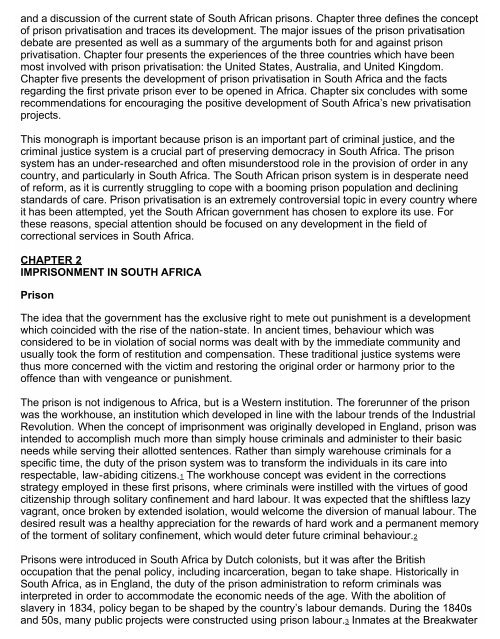prison privatisation in south africa issues, challenges and ...
prison privatisation in south africa issues, challenges and ...
prison privatisation in south africa issues, challenges and ...
Create successful ePaper yourself
Turn your PDF publications into a flip-book with our unique Google optimized e-Paper software.
<strong>and</strong> a discussion of the current state of South African <strong>prison</strong>s. Chapter three def<strong>in</strong>es the concept<br />
of <strong>prison</strong> <strong>privatisation</strong> <strong>and</strong> traces its development. The major <strong>issues</strong> of the <strong>prison</strong> <strong>privatisation</strong><br />
debate are presented as well as a summary of the arguments both for <strong>and</strong> aga<strong>in</strong>st <strong>prison</strong><br />
<strong>privatisation</strong>. Chapter four presents the experiences of the three countries which have been<br />
most <strong>in</strong>volved with <strong>prison</strong> <strong>privatisation</strong>: the United States, Australia, <strong>and</strong> United K<strong>in</strong>gdom.<br />
Chapter five presents the development of <strong>prison</strong> <strong>privatisation</strong> <strong>in</strong> South Africa <strong>and</strong> the facts<br />
regard<strong>in</strong>g the first private <strong>prison</strong> ever to be opened <strong>in</strong> Africa. Chapter six concludes with some<br />
recommendations for encourag<strong>in</strong>g the positive development of South Africa’s new <strong>privatisation</strong><br />
projects.<br />
This monograph is important because <strong>prison</strong> is an important part of crim<strong>in</strong>al justice, <strong>and</strong> the<br />
crim<strong>in</strong>al justice system is a crucial part of preserv<strong>in</strong>g democracy <strong>in</strong> South Africa. The <strong>prison</strong><br />
system has an under-researched <strong>and</strong> often misunderstood role <strong>in</strong> the provision of order <strong>in</strong> any<br />
country, <strong>and</strong> particularly <strong>in</strong> South Africa. The South African <strong>prison</strong> system is <strong>in</strong> desperate need<br />
of reform, as it is currently struggl<strong>in</strong>g to cope with a boom<strong>in</strong>g <strong>prison</strong> population <strong>and</strong> decl<strong>in</strong><strong>in</strong>g<br />
st<strong>and</strong>ards of care. Prison <strong>privatisation</strong> is an extremely controversial topic <strong>in</strong> every country where<br />
it has been attempted, yet the South African government has chosen to explore its use. For<br />
these reasons, special attention should be focused on any development <strong>in</strong> the field of<br />
correctional services <strong>in</strong> South Africa.<br />
CHAPTER 2<br />
IMPRISONMENT IN SOUTH AFRICA<br />
Prison<br />
The idea that the government has the exclusive right to mete out punishment is a development<br />
which co<strong>in</strong>cided with the rise of the nation-state. In ancient times, behaviour which was<br />
considered to be <strong>in</strong> violation of social norms was dealt with by the immediate community <strong>and</strong><br />
usually took the form of restitution <strong>and</strong> compensation. These traditional justice systems were<br />
thus more concerned with the victim <strong>and</strong> restor<strong>in</strong>g the orig<strong>in</strong>al order or harmony prior to the<br />
offence than with vengeance or punishment.<br />
The <strong>prison</strong> is not <strong>in</strong>digenous to Africa, but is a Western <strong>in</strong>stitution. The forerunner of the <strong>prison</strong><br />
was the workhouse, an <strong>in</strong>stitution which developed <strong>in</strong> l<strong>in</strong>e with the labour trends of the Industrial<br />
Revolution. When the concept of im<strong>prison</strong>ment was orig<strong>in</strong>ally developed <strong>in</strong> Engl<strong>and</strong>, <strong>prison</strong> was<br />
<strong>in</strong>tended to accomplish much more than simply house crim<strong>in</strong>als <strong>and</strong> adm<strong>in</strong>ister to their basic<br />
needs while serv<strong>in</strong>g their allotted sentences. Rather than simply warehouse crim<strong>in</strong>als for a<br />
specific time, the duty of the <strong>prison</strong> system was to transform the <strong>in</strong>dividuals <strong>in</strong> its care <strong>in</strong>to<br />
respectable, law-abid<strong>in</strong>g citizens.1 The workhouse concept was evident <strong>in</strong> the corrections<br />
strategy employed <strong>in</strong> these first <strong>prison</strong>s, where crim<strong>in</strong>als were <strong>in</strong>stilled with the virtues of good<br />
citizenship through solitary conf<strong>in</strong>ement <strong>and</strong> hard labour. It was expected that the shiftless lazy<br />
vagrant, once broken by extended isolation, would welcome the diversion of manual labour. The<br />
desired result was a healthy appreciation for the rewards of hard work <strong>and</strong> a permanent memory<br />
of the torment of solitary conf<strong>in</strong>ement, which would deter future crim<strong>in</strong>al behaviour.2<br />
Prisons were <strong>in</strong>troduced <strong>in</strong> South Africa by Dutch colonists, but it was after the British<br />
occupation that the penal policy, <strong>in</strong>clud<strong>in</strong>g <strong>in</strong>carceration, began to take shape. Historically <strong>in</strong><br />
South Africa, as <strong>in</strong> Engl<strong>and</strong>, the duty of the <strong>prison</strong> adm<strong>in</strong>istration to reform crim<strong>in</strong>als was<br />
<strong>in</strong>terpreted <strong>in</strong> order to accommodate the economic needs of the age. With the abolition of<br />
slavery <strong>in</strong> 1834, policy began to be shaped by the country’s labour dem<strong>and</strong>s. Dur<strong>in</strong>g the 1840s<br />
<strong>and</strong> 50s, many public projects were constructed us<strong>in</strong>g <strong>prison</strong> labour.3 Inmates at the Breakwater
















